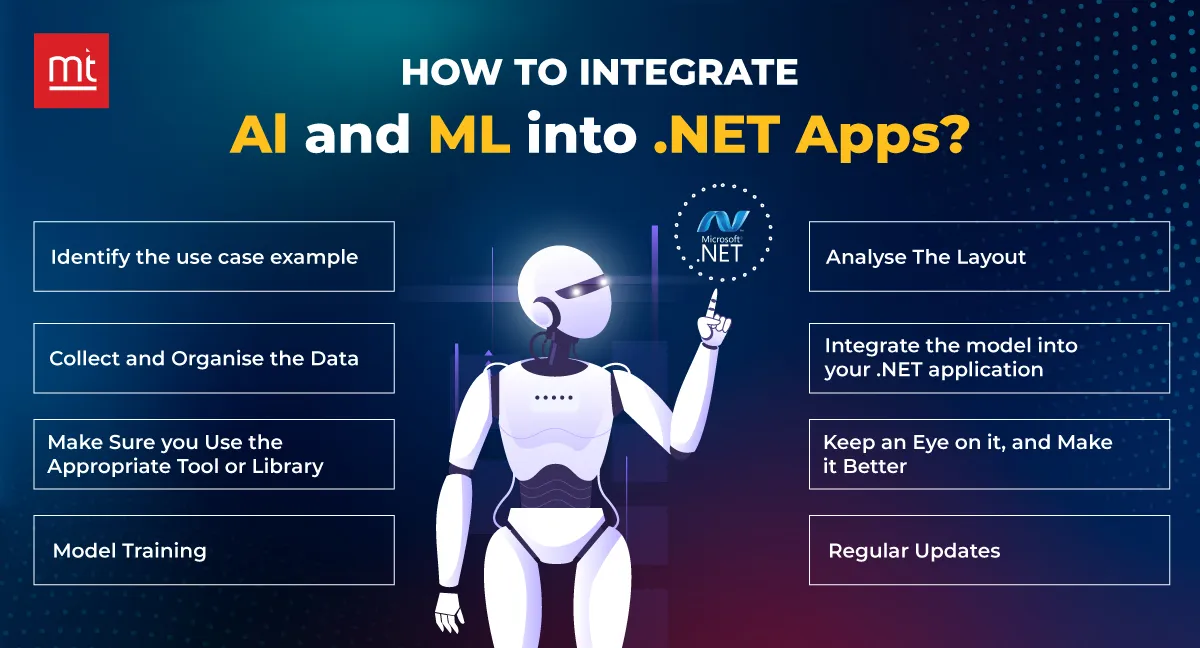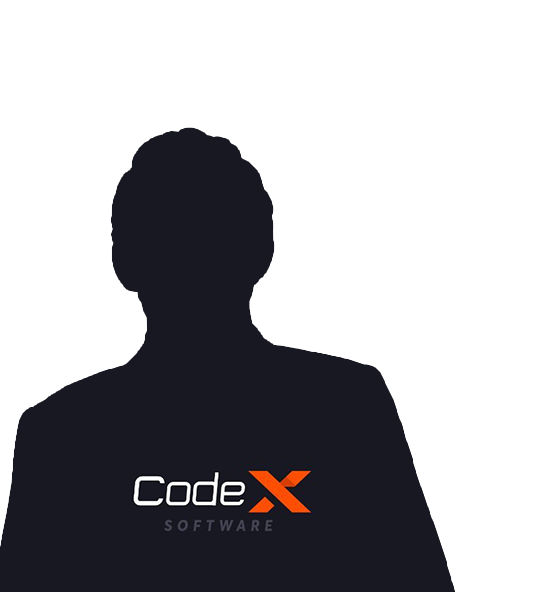Introduction
Businesses have been using.NET programs for more than 20 years. Exceptional security, flexibility, and efficiency compared to alternative solutions are offered by them. It's no secret that.NET applications are essential to businesses all over the world for a variety of purposes, including automating repetitive tasks, accelerating laborious processes, and increasing worker productivity. Businesses today are attempting to integrate AI and ML with.NET applications in an effort to increase efficiency.
You can quickly link your internal IT network to databases, services, and apps from outside sources using.NET. It makes it possible for them to maximise the value of the information they get and use data effectively.
The question that now needs to be answered is: how can the website incorporate machine learning or the ML model? And how to get the best .NET Development Services.
The blog discusses how to integrate AI and ML with.NET applications as well as the various use cases for AI and ML-powered.NET applications.
Understanding Al and ML Basics
Applications like.NET are being revolutionized by transformative technologies like Artificial Intelligence (AI) and Machine Learning (ML). Whereas ML gives systems the ability to learn from data and get smarter, AI allows machines to mimic human intelligence.
Statistics:
Global spending on AI hit $50.1 billion in 2022, up 32% from the year before.
By 2028, the ML market is projected to be valued at over $96 billion.
AI Basics:
Using AI, systems that carry out tasks requiring human intelligence can be created. When using.NET applications,
AI facilitates predictive functions, streamlines workflows, and improves decision-making.
ML Basics:
ML is a branch of AI that focuses on creating algorithms that let computers recognize patterns and anticipate outcomes based on data. Machine learning (ML) adds dynamic features to.NET apps, such as predictive analytics and tailored recommendations. Leverage ai ml development services for best integration.
Why .NET and AI/ML?
A strong framework for smoothly Implementing Artificial Intelligence with .NET.
ML.NET from Microsoft makes ML integration easier to use and more accessible for.NET developers.
It's critical to comprehend the fundamentals of AI and ML since these technologies will continue to influence.NET applications in the future. Accepting their potential guarantees the creation of data-driven, intelligent, and adaptable solutions.
What are the reasons to Implement Artificial Intelligence and Machine Learning in .NET Applications?
Software capabilities are enhanced to previously unheard-of levels when Artificial Intelligence (AI) and Machine Learning (ML) are integrated into.NET applications.
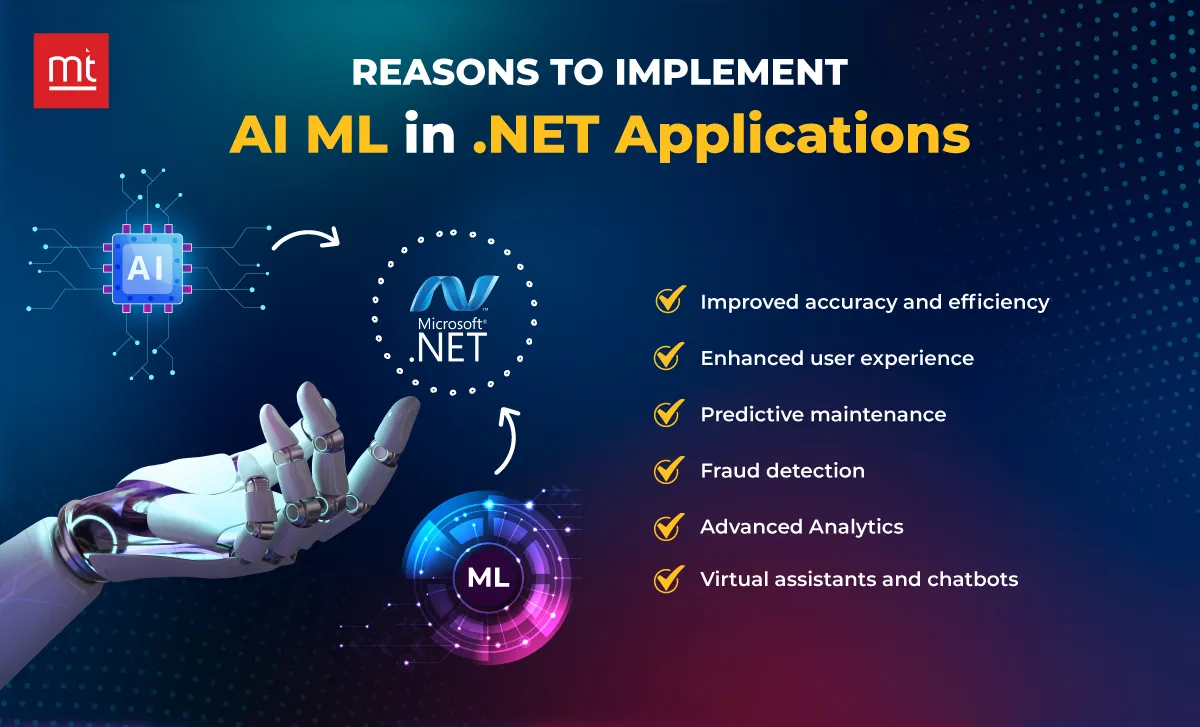
1. Improved accuracy and efficiency
The accuracy and productivity of.NET applications are improved by the use of AI and ML. Over time, sophisticated algorithms are able to perform tasks with increased accuracy because they are constantly learning and adapting.
2. Enhanced user experience
An easy and personalized user experience is made possible by AI and ML. By analyzing user behavior, preferences, and patterns, these technologies enable.NET applications to customize interactions, leading to an interface that is more engaging and easy to use.
3. Predictive maintenance
Predictive maintenance capabilities are made possible by integrating AI and ML with.NET. Applications have the ability to predict problems and inefficiencies, which enables preventative actions, minimizes downtime, and improves system performance overall.
4. Fraud detection
Pattern and anomaly detection is an area in which AI and ML excel. These technologies are extremely helpful in detecting fraud in.NET applications, as they quickly identify anomalies and improve security protocols to prevent fraudulent activity.
5. Advanced Analytics
Advanced analytics are made possible by the integration of AI and ML into.NET applications. Large-scale datasets are analyzed by these technologies, which offer insightful analysis and enable businesses to make data-driven decisions that improve overall productivity and competitiveness.
6. Virtual assistants and chatbots
Chatbots and virtual assistants powered by AI can be easily integrated with.NET applications to give users responsive and interactive user interfaces. By improving communication, responding to inquiries, and streamlining user interactions, these intelligent agents promote a more engaging user experience. Hire .NET developers for integrating at best capacity.
In conclusion, using AI and ML in.NET applications is a calculated step towards innovation rather than merely a fad. The combination of these technologies opens up a world of possibilities, launching your applications into a new phase of intelligent and adaptive computing. These possibilities range from increasing accuracy and efficiency to enabling predictive maintenance and advanced analytics.
How to Integrate Al and ML into .NET Apps?
Are you starting the process of incorporating machine learning (ML) and artificial intelligence (AI) into your.NET application? For a smooth integration procedure, adhere to these steps:
1. Identify the use case example
Clearly state the issue that you want to use ML and AI to solve. Choose a real-world situation that fits the objectives of your application.
2. Collect and Organize the Data
Compile pertinent information for your use case. Make sure it's tidy, well-organized, and enough for training your model. The cornerstone of an effective AI and ML integration is high-quality data.
3. Make Sure you Use the Appropriate Tool or Library
Select the appropriate AI and ML libraries or tools according to the needs of your project. TensorFlow, PyTorch, and ML.NET are well-liked choices for smooth interaction with.NET apps.
4. Model Training
Use the gathered data to train your machine learning model. To improve accuracy, change configurations and parameters. This is an essential step in creating a reliable and functional model.
5. Analyze The Layout
Recognize how the architecture of your.NET application will accommodate your AI/ML model. For best results, confirm compatibility and pinpoint integration points.
6. Integrate the model into your .NET application
Incorporate the learned model into your.NET program. Use the selected tool or library to combine AI and ML features in a seamless manner.
7. Keep an Eye on it, and Make it Better
Keep an eye on your integrated model's and hire android app developers for performance on a regular basis. To increase the accuracy and efficiency of the model, pinpoint its weak points and make necessary adjustments.
8. Regular Updates
Keep up with the latest developments in ML and AI technologies. Update your model on a regular basis to keep it current with advancements and relevant.
You can successfully integrate AI and ML capabilities into your.NET application by following these steps, which will improve functionality and help you stay on the cutting edge of technology.
What are the Prominent NET Frameworks and .NET Core Al and ML Libraries?
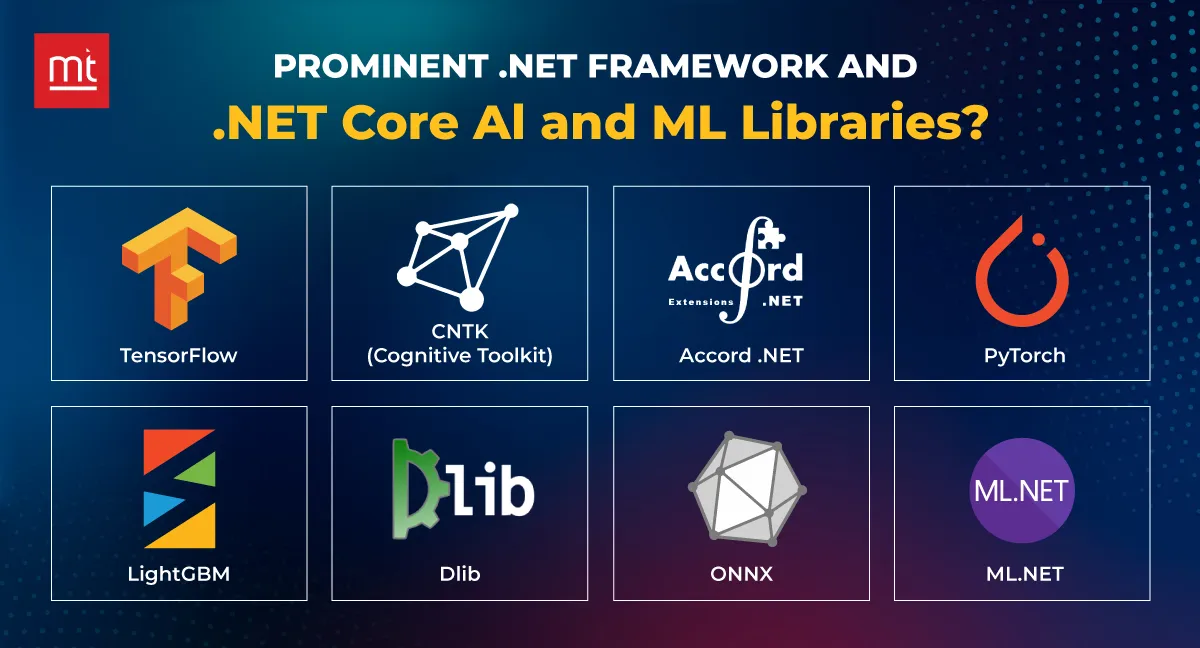
1. TensorFlow
A powerful open-source machine learning framework. Widely used for building and training deep learning models.
2. CNTK (Cognitive Toolkit)
Developed by Microsoft Research for deep learning tasks. Efficiently handles speech, image, and text data.
3. Accord .NET
Comprehensive machine learning framework for .NET. Offers a wide range of algorithms and statistical tools.
4. PyTorch
An open-source machine learning library with a dynamic computation graph. Popular for its flexibility and ease of use.
5. LightGBM
A gradient boosting framework that efficiently handles large datasets. Known for its speed and high-performance in machine learning tasks.
6. Dlib
A toolkit for machine learning and computer vision tasks. Particularly strong in facial recognition and image processing.
7. ONNX
An open-source format for AI models. Facilitates interoperability between different frameworks. It can help with How to Use AI and ML with .NET App.
8. ML.NET
A cross-platform, open-source machine learning framework from Microsoft. Integrates seamlessly with .NET applications.
These well-known.NET frameworks and libraries offer a strong basis for the development of AI and machine learning. Whether you're using Microsoft's CNTK for deep learning, TensorFlow for deep learning, or PyTorch for its versatility, the.NET ecosystem provides an extensive collection of tools for your AI and ML projects.
Use Case of Artificial Intelligence and Machine Learning in.NET
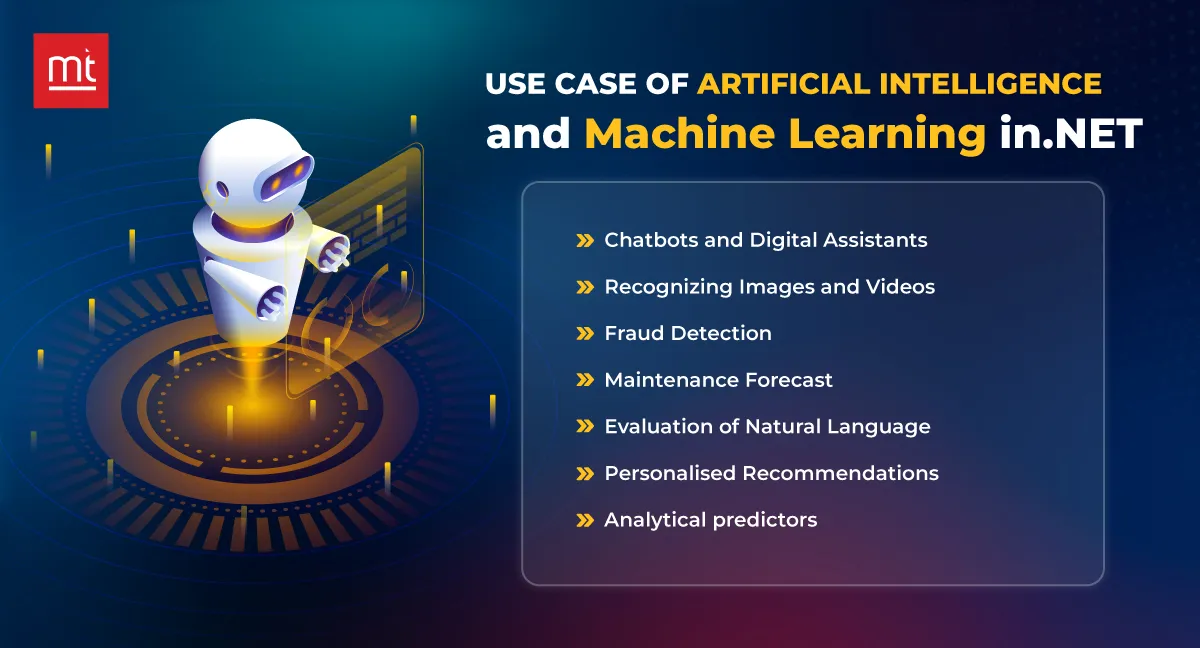
1. Chatbots and Digital Assistants
Create intelligent chatbots and digital assistants by utilizing AI and ML with.NET. Improve customer engagement dramatically by personalizing experiences, streamlining user interactions, and automating responses.
2. Recognizing Images and Videos
AI and ML work wonders with.NET when it comes to image and video recognition. Use advanced algorithms for content analysis, face recognition, and object detection to create new opportunities in the security and medical fields, among other areas.
3. Fraud Detection
With the help of.NET's AI and ML capabilities, safeguard your systems against fraudulent activity. Identify anomalies, odd trends, and possible security risks instantly to strengthen your anti-fraud defenses.
4. Maintenance Forecast
Use ML and AI models in.NET to perform predictive maintenance. Predict equipment failures by analyzing historical data, which enables proactive maintenance plans and reduces downtime.
5. Evaluation of Natural Language
Natural language processing is enhanced by.NET's AI and ML algorithms. Recognize and analyze text data for better decision-making and user experiences, from sentiment analysis to language translation.
6. Personalized Recommendations
By integrating personalized recommendation systems in.NET, you can raise user satisfaction. To provide personalized content, goods, or services, AI and ML algorithms examine user behavior, preferences, and historical data.
7. Analytical predictors
AI and ML are strong analytical predictors in.NET. Make use of sophisticated algorithms to predict trends, examine patterns, and extract knowledge to assist decision-makers in making well-informed decisions in a variety of fields.
Discover the enormous possibilities of machine learning and artificial intelligence with a seamless.NET integration. These use cases demonstrate the revolutionary impact of AI and ML in the.NET ecosystem, from chatbots revolutionizing customer interactions to fraud detection fortifying security.
Exploring upcoming trends in Al and ML in the NET ecosystem.
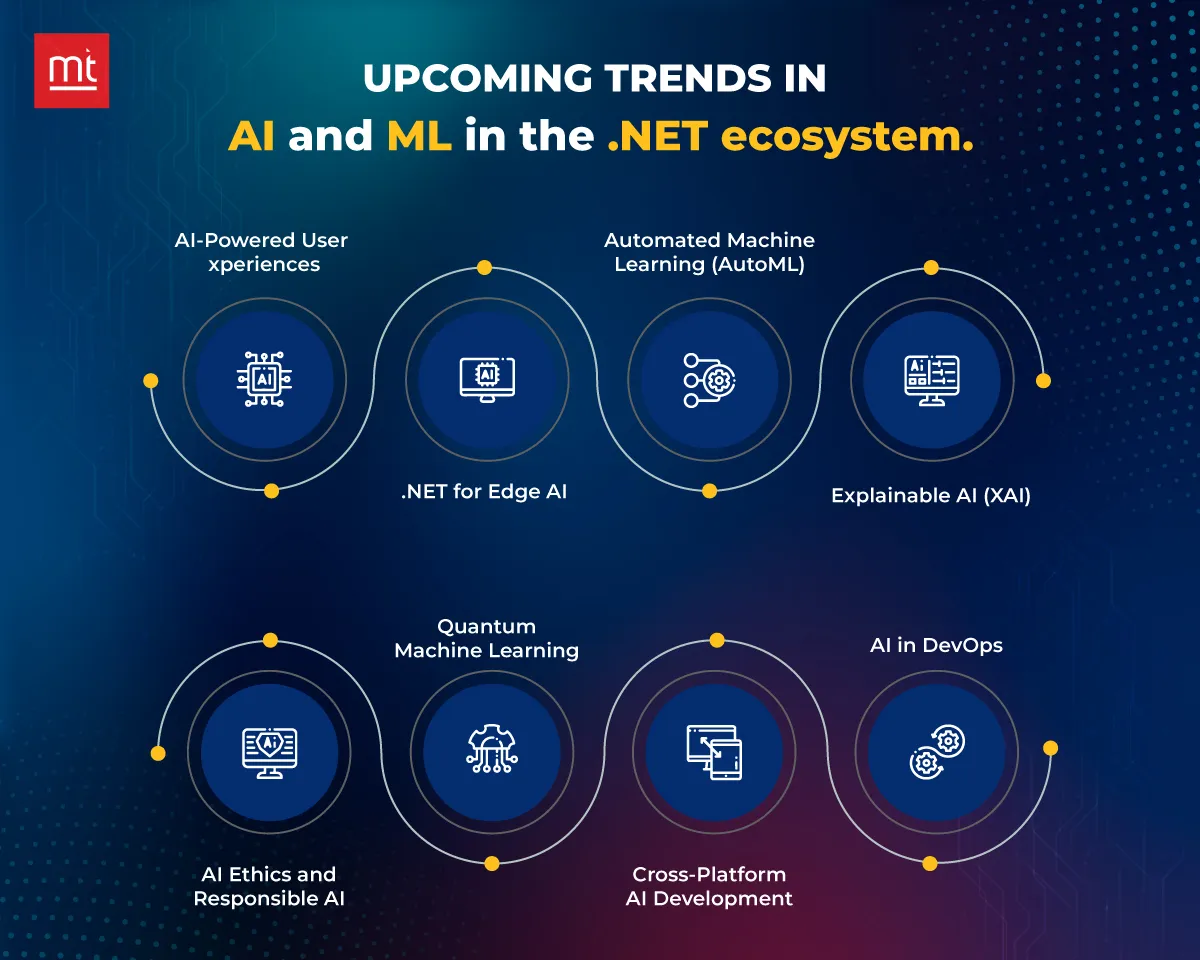
By now you might be aware about How to Integrate AI and ML into .NET Apps? The.NET ecosystem is set up for exciting developments in machine learning and artificial intelligence as we move forward (ML and AI). Here's a sneak peek at the next big things that will change everything:
1. AI-Powered User Experiences:
- Integration of AI into .NET applications for personalized and intuitive user experiences.
- Predictive analytics enhancing user interactions and anticipating user needs.
2. .NET for Edge AI:
- Increasing adoption of .NET for Edge AI applications, pushing the boundaries of decentralized processing.
- Enhanced performance and real-time decision-making on edge devices.
3. Automated Machine Learning (AutoML):
- .NET embracing AutoML for automating the end-to-end process of applying ML to real-world problems.
- Simplified ML model development, making it more accessible to developers.
4. Explainable AI (XAI):
- Rising demand for transparency in AI decision-making.
- Integration of XAI principles into .NET applications for understandable and trustworthy AI models.
5. AI Ethics and Responsible AI:
- Growing focus on ethical considerations in AI and ML development.
- .NET developers incorporating responsible AI practices, ensuring fairness and accountability.
6. Quantum Machine Learning:
- Exploration of quantum computing's potential in .NET for solving complex ML problems.
- Bridging the gap between classical and quantum computing for advanced machine learning tasks.
7. Cross-Platform AI Development:
- .NET fostering cross-platform AI development for seamless deployment across various environments.
- Unifying AI solutions for consistency and efficiency across different platforms.
8. AI in DevOps:
- Integration of AI and ML in the DevOps lifecycle within the .NET ecosystem.
- Automated testing, code optimization, and predictive analytics for more efficient development processes.
In the.NET ecosystem, AI and ML have a bright and promising future. Developers will take advantage of these trends to produce cutting-edge, perceptive, morally-driven solutions that stretch the bounds of what is conceivable. Keeping up with these trends will be essential to navigating this changing technological landscape and remaining at the forefront of innovation.
How Much Does it Cost to Integrate Al?
The cost of integrating artificial intelligence (AI) into your systems can vary greatly depending on a number of variables. The degree of customization, the extent of integration, and the intricacy of the AI solution all influence the price. More funding might be needed for customized AI solutions made to meet particular business requirements.
Among the variables affecting costs are:
- Development Time: Costs are impacted by the intricacy of the AI solution and the amount of time needed for development.
- Data Quality: Reliable data is essential for AI to function well. Data preparation and cleaning can increase expenses.
- Selecting an AI Model: The total budget is impacted by the various costs associated with each AI model.
- Integration with Current Systems: It might take more time and money to integrate existing systems seamlessly.
- Updating and Maintenance: The ongoing cost of integrating AI into business is influenced by updates and maintenance.
For accurate cost estimates, consulting with AI development professionals is recommended. Investing in AI can enhance efficiency and provide valuable insights, making it a strategic decision for many businesses.
Why Choose ManekTech for Developing Al and ML-based .NET Applications?
Select ManekTech as your.NET application development partner for AI and ML, and benefit from our unmatched experience and creativity. Our committed team of experts is skilled at utilizing.NET's capabilities to develop innovative solutions that are loaded with AI and machine learning.
At ManekTech, providing solutions that support your company's goals is our top priority. Our expertise with.NET guarantees dependable, scalable, and high-performing applications. We use cutting-edge technologies to improve functionality, automate procedures, and extract insightful data when it comes to AI and ML integration.
Our dedication to excellence, open communication, and client-centered methodology are what make us unique. We work closely with you to comprehend your particular needs so that the finished product meets and surpasses your expectations. You can rely on ManekTech to seamlessly integrate AI, ML, and.NET to deliver solutions that will advance your company's operations.
Conclusion
To sum up, the incorporation of AI and ML into.NET applications creates a world of opportunities for efficiency and creativity. This thorough manual has examined the nuances of combining these cutting-edge technologies and provides advice on creating smart applications. It is critical to comprehend how AI and ML fit into the.NET ecosystem as businesses use them more and more.
With this guide in hand, mobile app development services can set out to create intelligent, sophisticated apps that not only meet but also surpass the demands of the changing digital landscape, guaranteeing a competitive and future-ready software environment. Use the power of AI and ML to elevate your.NET apps and open the door to revolutionary possibilities.
About Author
Subscribe to Our Newsletter!
Join us to stay updated with our latest blog updates, marketing tips, service tips, trends, news and announcements!

